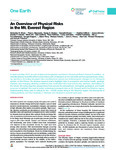An Overview of Physical Risks in the Mt. Everest Region
| dc.contributor.author | Miner, KR | |
| dc.contributor.author | Mayewski, PA | |
| dc.contributor.author | Baidya, SK | |
| dc.contributor.author | Broad, K | |
| dc.contributor.author | Clifford, H | |
| dc.contributor.author | Elmore, A | |
| dc.contributor.author | Gajurel, AP | |
| dc.contributor.author | Giri, B | |
| dc.contributor.author | Guilford, S | |
| dc.contributor.author | Hubbard, M | |
| dc.contributor.author | Jaskolski, C | |
| dc.contributor.author | Koldewey, H | |
| dc.contributor.author | Li, W | |
| dc.contributor.author | Matthews, T | |
| dc.contributor.author | Napper, I | |
| dc.contributor.author | Perry, LB | |
| dc.contributor.author | Potocki, M | |
| dc.contributor.author | Priscu, JC | |
| dc.contributor.author | Tait, A | |
| dc.contributor.author | Thompson, Richard | |
| dc.contributor.author | Tuladhar, S | |
| dc.date.accessioned | 2021-08-20T13:31:36Z | |
| dc.date.available | 2021-08-20T13:31:36Z | |
| dc.date.issued | 2020-11 | |
| dc.identifier.issn | 2590-3322 | |
| dc.identifier.issn | 2590-3322 | |
| dc.identifier.uri | http://hdl.handle.net/10026.1/17620 | |
| dc.description.abstract |
In April and May 2019, as part of National Geographic and Rolex's Perpetual Planet Everest Expedition, an interdisciplinary scientific effort conducted a suite of research on the mountain and recognized many changing dynamics, including emergent risks resulting from natural and anthropogenic changes to the biological system. In this Primer, the diverse research teams highlight risks to ecosystem and human health, geologic hazards, and changing climbing conditions that could affect the local community, climbers, and trekkers in the future. We bring together perspectives from across the atmospheric, biological, geological, and health sciences to highlight the need to better understand emergent risks on Mt. Everest and in the Khumbu region. Understanding these risks is critical for the ∼10,000 people living in the Khumbu region, the thousands of visiting trekkers, and the hundreds of climbers who attempt to summit each year. | |
| dc.format.extent | 547-550 | |
| dc.language | en | |
| dc.language.iso | en | |
| dc.publisher | Elsevier BV | |
| dc.title | An Overview of Physical Risks in the Mt. Everest Region | |
| dc.type | journal-article | |
| dc.type | Review | |
| dc.type | Journal | |
| plymouth.author-url | https://www.webofscience.com/api/gateway?GWVersion=2&SrcApp=PARTNER_APP&SrcAuth=LinksAMR&KeyUT=WOS:000646432300008&DestLinkType=FullRecord&DestApp=ALL_WOS&UsrCustomerID=11bb513d99f797142bcfeffcc58ea008 | |
| plymouth.issue | 5 | |
| plymouth.volume | 3 | |
| plymouth.publication-status | Published | |
| plymouth.journal | One Earth | |
| dc.identifier.doi | 10.1016/j.oneear.2020.10.008 | |
| plymouth.organisational-group | /Plymouth | |
| plymouth.organisational-group | /Plymouth/Faculty of Science and Engineering | |
| plymouth.organisational-group | /Plymouth/Faculty of Science and Engineering/School of Biological and Marine Sciences | |
| plymouth.organisational-group | /Plymouth/REF 2021 Researchers by UoA | |
| plymouth.organisational-group | /Plymouth/REF 2021 Researchers by UoA/UoA07 Earth Systems and Environmental Sciences | |
| plymouth.organisational-group | /Plymouth/Research Groups | |
| plymouth.organisational-group | /Plymouth/Research Groups/Marine Institute | |
| plymouth.organisational-group | /Plymouth/Users by role | |
| plymouth.organisational-group | /Plymouth/Users by role/Academics | |
| plymouth.organisational-group | /Plymouth/Users by role/Researchers in ResearchFish submission | |
| dcterms.dateAccepted | 2020-01-01 | |
| dc.rights.embargodate | 2021-12-23 | |
| dc.identifier.eissn | 2590-3322 | |
| dc.rights.embargoperiod | Not known | |
| rioxxterms.versionofrecord | 10.1016/j.oneear.2020.10.008 | |
| rioxxterms.licenseref.uri | http://www.rioxx.net/licenses/all-rights-reserved | |
| rioxxterms.licenseref.startdate | 2020-11 | |
| rioxxterms.type | Journal Article/Review |


